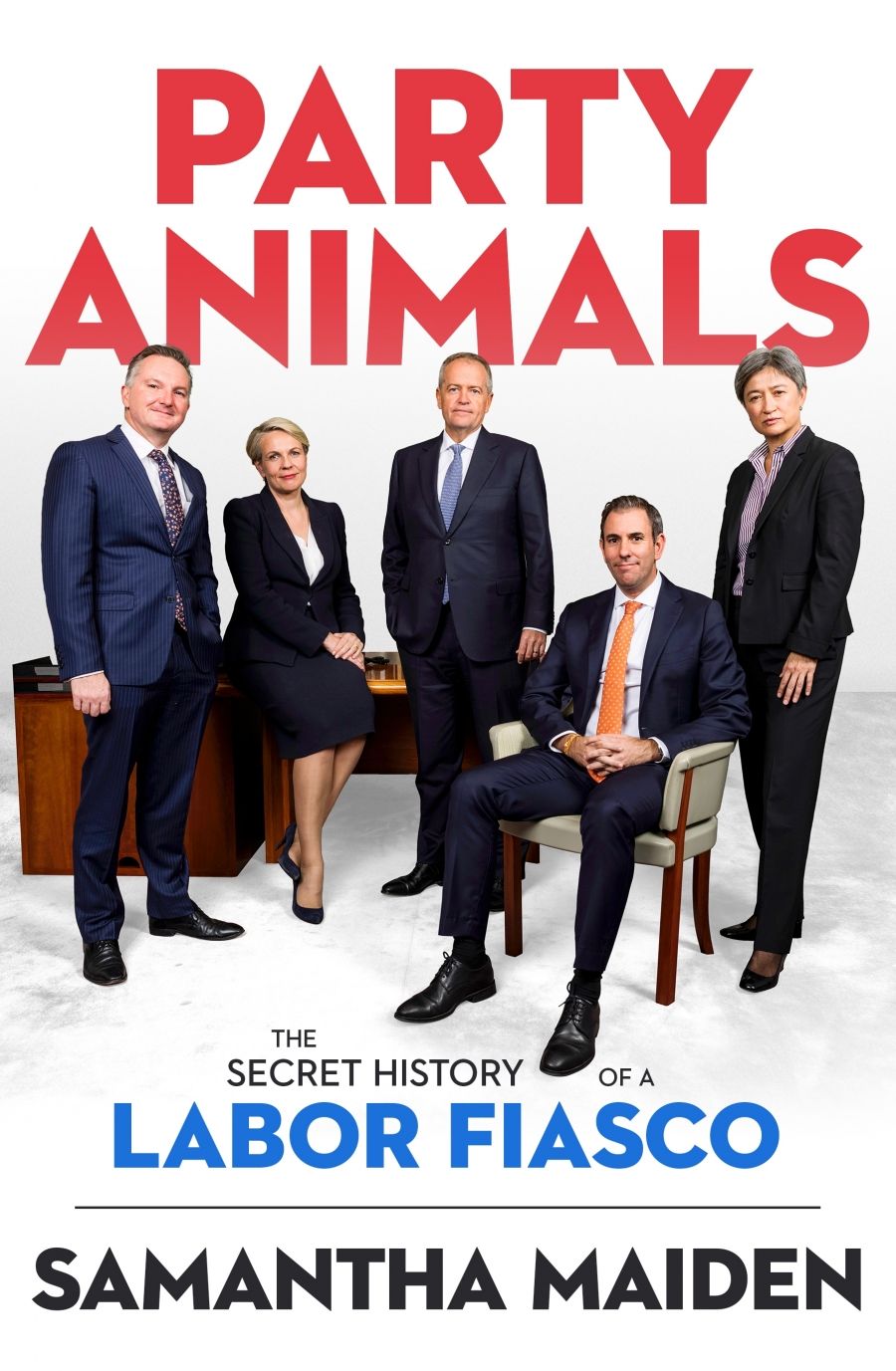
- Free Article: No
- Contents Category: Politics
- Review Article: Yes
- Custom Highlight Text:
There seem to be fewer post-election books doing the rounds after the 2019 federal campaign than has been the case in recent decades. Why is this? The 2019 campaign may have been achingly bland, but the result shocked pollsters, voters, and a news media that had long predicted a Labor win. Morrison’s ‘miracle’ victory is probably Australia’s most historically significant one since the last ‘unlosable’ election, back in 1993, when another cocksure opposition took its own ‘big target’ tax package to the people.
- Grid Image (300px * 250px):

- Book 1 Title: Party Animals
- Book 1 Subtitle: The secret history of a Labor fiasco
- Book 1 Biblio: Viking, $34.99 pb, 336 pp
Maiden provides a colourful chronicle of events before, during, and after Labor’s defeat. She reveals the sort of covert minutiae available only to Canberra insiders. We learn that George Brandis, Australia’s high commissioner to London, was fearful of being sacked by a Shorten government; and that former Labor Treasurer Wayne Swan didn’t speak to Anthony Albanese for years after the demise of Julia Gillard.
Maiden, of course, offers the usual post-election analysis of the factors driving the vote. Satisfyingly, she goes further than Labor’s own critical Emerson–Weatherill review. While Maiden doesn’t exactly refute the essence of the two most commonly cited causes – an unpopular Opposition leader in Bill Shorten and a ‘big target’ tax package – she does offer nuance in anatomising each, while busting some myths along the way.
Maiden, drawing on Australian Election Study (AES), disputes the widespread assumption that older and middle-class voters rejected Labor because of fears of negative gearing and franking credit reform. We now know that many older and wealthier voters in Sydney and Melbourne swung behind Labor, voting altruistically against their own economic interests. Maiden contends that Labor’s formerly rusted-on working-class voters, and a mercurial ‘fluoro collar’ aspirational class, spurned the Opposition because, with austerity measures looming, Labor and Shorten represented too great a risk to their interests. Labor failed to mitigate that suspicion or to counter the Coalition assault it must have known was coming. Maiden doubts the negative impact of a franking credit policy that would have affected a mere 6.5 per cent of taxpayers (and no pensioners) and that would have reaped $60 billion in revenue over ten years. She points out that AES data indicates that negative gearing and franking credit reforms were supported by fifty-seven and fifty-three per cent of voters, respectively.
 Voters at Mount View Primary School in the electorate of Chisholm for the 2019 Australian federal election (photograph by Chris Hopkins)
Voters at Mount View Primary School in the electorate of Chisholm for the 2019 Australian federal election (photograph by Chris Hopkins)
Maiden brings together a host of neglected factors in the election. There is a suggestion that Labor’s campaign director, Noah Carroll – who had never run a national campaign – was too ‘secretive’ with internal polling and focus-group data, and failed to communicate with the all-important leadership group (Shorten, Tanya Plibersek, Penny Wong, and Don Farrell, sometimes expanded to a ‘Gang of Seven’, with Chris Bowen, Jenny Macklin, and Tony Burke). Maiden notes a general lack of debate in the party – Shorten feared internal dissent and placed a premium on party unity after the recent chaos in the Liberal Party – and the fact that the caucus and shadow cabinet often acquiesced in decisions of the leadership group.
It is the book’s second critical contribution – a study of the increasingly close nexus between politics and the media – that will win it influence and readers, especially among journalism and public relations students. Maiden’s unpicking of the ‘Choppergate’ affair of 2014 – when Bronwyn Bishop, speaker of the House of Representatives, hired a helicopter to attend a Liberal Party fundraiser – is perhaps the most revealing. We learn that this self-indulgence, which soon became a scandal and eventually unseated her, came to light as a result of work done not by news media journalists, as we were led to believe at the time, but by ‘young Labor staffers’ in Shorten’s office. Maiden argues that, in an age when media outlets (even the Canberra press gallery) are being gutted by digital publishing, researchers in party offices have become essential (though partisan) arms of the Fourth Estate, keeping political rivals accountable, if only through digging for dirt. Maiden writes that Labor was ‘running one of the most methodical, relentless and successful investigative journalism units in Australia’. Maiden’s account of how Labor uncovered Bishop’s chopper ride is worth the price of the book alone. Suffice to say that the first ‘Choppergate’ story, fed to Melbourne’s Herald Sun, contained no Labor quotes: the story was not to appear like a Labor ‘drop’ but rather a piece of ‘shoe leather’ journalism from which community outrage would grow organically.
Maiden rounds out the book with an important chapter on the polarising Adani coal mine and on mining billionaire Clive Palmer, whose United Australia Party preferences, along with those from Pauline Hanson’s One Nation, would buttress Coalition seats in Queensland. Arguably, some content towards the end is misplaced. The sad tale of former New South Wales State Secretary Kaila Murnain appears to enjoy greater emphasis than that of former Senator Sam Dastyari, while some biographical material on Shorten – his first day with the AWU, for example – would be more at home in early chapters. The lack of index is frustrating, but the narrative is strong and the prose friendly.
Samantha Maiden concludes with a discussion of Albanese as a ‘destiny thing’. The fact that Albanese is not Shorten means that victory for Labor is indeed conceivable at the next federal election – as is the possibility that Scott Morrison’s leadership will be enhanced by the current pandemic.


Comments powered by CComment